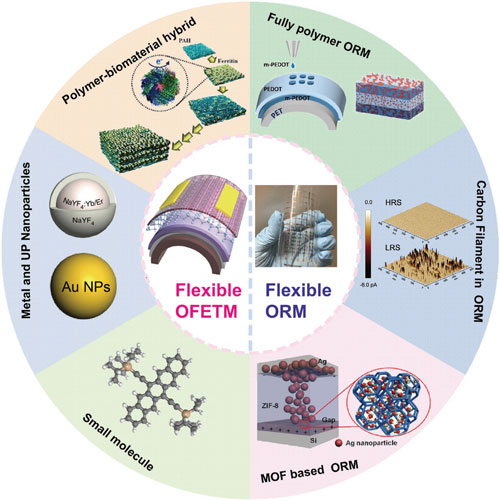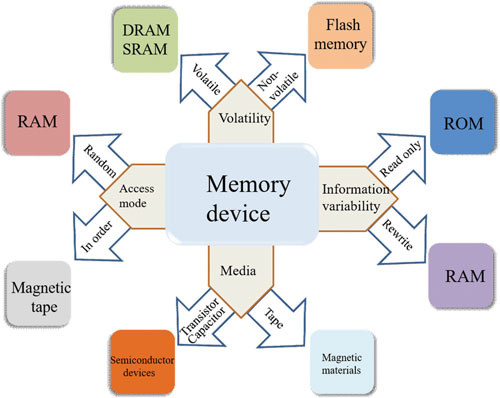| Posted: Apr 09, 2018 | |
Flexible data storage based on organic nanomaterials |
|
| (Nanowerk Spotlight) Next-generation electronic devices will be highly portable, wearable – even transplantable – lightweight, and most likely self-powered. Among the various functional block required for these systems (such as displays, sensors, actuators, etc), some of the most important components are novel flexible data storage systems that possess nonvolatile ability, high-density storage, high-switching speed, and reliable endurance properties. | |
| Research groups around the world are focusing on the investigation of new flexible memories, which own nonvolatile capability, high-density storage, fast switching, and reliable endurance property. Especially organic memories have been considered as the most promising candidates to be used in various portable and wearable systems in future due to their remarkable advantages of nonvolatile memory features, low cost, easy fabrication, and flexibility. | |
 |
|
| Schematic illustration of flexible data storage devices. (© Wiley-VCH Verlag) (click on image to enlarge) | |
| Nonvolatile flexible organic memories are constructed by a diversity of device layouts utilizing a variety of materials systems. The nonvolatile memories can be classified as capacitor-type, resistor-type and transistor-type memories. | |
| Capacitor-based memory (see our previous Nanowerk Spotlight: "Flexible FeRAM fabricated with CMOS-compatible approach") may face the problem of data storage loss as a result of the merely dielectric intermediate between the top and bottom electrodes. The most popular structures for organic memory device appeared in the literature so far are resistive-type and transistor-type. | |
| The structure of resistor-based memory (see for instance: "Atomristor – memristor effect in atomically thin nanomaterials") is very simple which is composed of two bottom/top cross electrodes and possess very high memory density. | |
| Transistor-based memories (read more: "Highly flexible organic flash memory for foldable and disposable electronics") own some advantages such as single transistor realization, nondestructive readout property, and are feasible to be integrated with complementary metal-oxide-semiconductor (CMOS) technology. | |
| Various kinds of materials including metal nanoparticles, polymeric materials, ferroelectric materials, organic small molecules, 2D materials, and hybrid composites have been developed for flexible organic memory device applications. | |
| A newly published review (Small, "Recent Advances of Flexible Data Storage Devices Based on Organic Nanoscaled Materials") surveys the recent studies and research activities related to flexible data storage devices based on organic nanoscaled materials. A particular focus is on the organic field effect transistor (OFET) memory with organic semiconductor and flexible resistive memory with organic materials. | |
| In the first part of this review, the authors give a brief introduction of the operation of data storage system. The second part is mainly an introduction of the operation of data storage systems. The third part reviews various charge trapping materials of flexible OFET. The fourth part is about the flexible resistive memory with organic materials. At the conclusion of their review, the authors outline the challenges and opportunities for the further development of flexible organic memory. | |
| The term memory is often used to describe a data storage device in the computer system. The conventional storage unit consists of a bistable semiconductor circuit, which can store the byte code. Many storage units can form the memory cells. According to the nature of storage materials and different properties, conventional memory devices can be classified to a variety of types, as shown in the figure below. | |
 |
|
| Schematic illustration of the classification of memory devices. (© Wiley-VCH Verlag) (click on image to enlarge) | |
| In their article, the authors focus on the elucidation of the device structure, memory characteristics, device operation mechanism, and mechanical property of a series of flexible organic nonvolatile memories, from OFET based memory, including floating-gate, charge-trapping, and ferroelectric architectures, to organic resistive memory. | |
| They discuss the various functional materials including nanoparticles, 2D materials, small molecules, conjugated polymers, hybrid organic/inorganic composite, etc. that have been developed for the above-mentioned memory devices on flexible substrates. | |
| In addition, they also touch upon the various strategies for fabricating the flexible organic memories. | |
| Although the memory performance of organic memory device cannot compete yet with that of the Si based memory device, organic memories with high density and high switching speed are big supplement in the large market for nonvolatile semiconductor memories. | |
| Concluding their review, the authors list several challenges that must be addressed before flexible organic nonvolatile memory can be practically applied: | |
| First, the electrical performance should be improved. Second, improve the mechanical flexibility and stability: flexibility is the most basic requirement for flexible electronic technology, and it is necessary to achieve stretchable and foldable requirements for actual products, the device performance stability should be maintained when the flexible substrates under large degree of bending conditions. | |
| In addition, organic field effect transistor memory (OFETM) and organic resistive memory (ORM) may face the problems of device-to-device inconsistency and cell non-reproducibility due to the uncertainty in the film's microstructure with the solution fabrication process. Higher device yield should be achieved for practical applications. | |
| To satisfy these requirements, close collaborations various disciplines from chemistry, material science, physics, to electronic engineering are indispensable, the authors conclude. | |
 By
Michael
Berger
– Michael is author of three books by the Royal Society of Chemistry:
Nano-Society: Pushing the Boundaries of Technology,
Nanotechnology: The Future is Tiny, and
Nanoengineering: The Skills and Tools Making Technology Invisible
Copyright ©
Nanowerk LLC
By
Michael
Berger
– Michael is author of three books by the Royal Society of Chemistry:
Nano-Society: Pushing the Boundaries of Technology,
Nanotechnology: The Future is Tiny, and
Nanoengineering: The Skills and Tools Making Technology Invisible
Copyright ©
Nanowerk LLC
|
|
|
Become a Spotlight guest author! Join our large and growing group of guest contributors. Have you just published a scientific paper or have other exciting developments to share with the nanotechnology community? Here is how to publish on nanowerk.com. |
|
